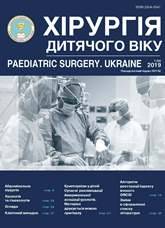Idiopathic chylothorax in newborns: clinical cases
DOI:
https://doi.org/10.15574/PS.2019.64.47Keywords:
idiopathic chylothorax, newborns, diagnosis, conservative treatment, thoracoscopic ligation of the ductAbstract
Chylothorax is a life-threatening condition with accumulation of lymphatic fluid in the pleural cavity can lead to the development of cardiopulmonary failure. The trauma of thoracic lymphatic duct or malformations of mediastinal organs can be the causes of chylothorax. There are congenital or idiopathic chylothorax. Traumatic chylothorax occurs when the chest lymph duct is damaged during cardiac surgery or operations on the organs of the chest. Development of chylothorax is most often associated with cancer and traumatic damage to the thoracic lymphatic duct in adults. The cases of this pathology in congenital malformations of the respiratory and lymphatic systems observed more rare.The article describes three clinical cases of idiopathic chylothorax in newborns. Mothers of all three patients had a burdened obstetric and gynecological history, in addition, all these children were at risk for the development of intrauterine infection, bronchopulmonary pathology and hemorrhagic syndrome. When transferred to RNPC of pediatric surgery, the condition of each child was regarded as severe, due to respiratory failure and metabolic disorders. All of these newborns were hospitalized in the intensive care unit, one of them underwent prolonged artificial lung ventilation. The criteria for the diagnosis of chylothorax were including clinical manifestations and laboratory assessment of triglyceride levels, as well as the absolute number and fractions of lymphocytes in the pleural aspirate. Complex conservative treatment with complete abolition of enteral nutrition, correction of metabolic disorders and hypoproteinemia, decompression of the pleural cavity and replacement of fluid loss through pleural drains were carried out. Thoracoscopic surgery was performed for all patients, due to the lack of clinical effect of conservative therapy. Indications for surgical treatment were: long-term (more than 2 weeks) and significant (from 70 to 200 ml per day) the expiry of the chylous fluid from the pleural cavity and absence of conservative therapy effect. In all cases, surgical treatment was carried out: thoracoscopic clipping ore ligation of the thoracic lymph duct or coagulation of the lymph flow zone. Intraoperative anatomical cause of chylothorax development were not revealed in any case.
The research was carried out in accordance with the principles of the Helsinki Declaration. The study protocol was approved by the Local Ethics Committee of all participating institution. The informed consent of the patient was obtained for conducting the studies.
No conflict of interest was declared by the authors.
References
Bulbul A, Okan F, Nuhoglu A. (2009). Idiopathic congenital chylothorax presented with severe hydrops and treated with octreotide in term newborn. J Matern Fetal Neonatal Med. 22(12): 1197-200. https://doi.org/10.3109/14767050903029618; PMid:19916717
Buttiker V, Fanconi S, Burger R. (1999). Chylothorax in children: guidelines for diagnosis and management. Chest. 116(3): 682-7. https://doi.org/10.1378/chest.116.3.682; PMid:10492271
Cormack BE, Wilson NJ, Finucane K, West TM. (2004). Use of monogen for pediatric postoperative chylothorax. Ann Thorac Surg. 77: 301-5. https://doi.org/10.1016/S0003-4975(03)01189-5
Copons FC, Benitez SI, Castillo SF, Salcedo AS. (2008). Neonatal chylothorax: aetiology, clinical course and efficacy of treatment. An. Pediatr (Barc). 68(3): 224-31. https://doi.org/10.1157/13116701; PMid:18358132
Gonzalez R, Bryner BS, Teitelbaum DH, Hirschl RB, Drongowski RA, Mychaliska GB. (2009). Chylothorax after congenital diaphragmatic hernia repair. Pediatr. Surg. 44(6): 1181-5. https://doi.org/10.1016/j.jpedsurg.2009.02.021; PMid:19524736
Lessen R. (2009). Use of skim breast milk for an infant with chylothorax. ICAN (Infant, Child, and Adolescent Nutrition). 1(6): 303-10. https://doi.org/10.1177/1941406409353942
Lin CH, Lin WC, Chang JS. (2017). Presentations and management of different causes of chylothorax in children: one medical center’s experience. BioMedicine. 7(1);5: 30-4. https://doi.org/10.1051/bmdcn/2017070105; PMid:28474581 PMCid:PMC5439341
Moreira-Pinto J, Rocha P, Osorio A, Bonet B, Carvalho F, Duarte C, Oliveira L. (2011). Octreotide in the treatment of neonatal postoperative chylothorax: report of three cases and literature review. Pediatr Surg Int. 27: 805-9. https://doi.org/10.1007/s00383-010-2730-2
PMid:20821216
Sokolovskaya MA, Manerov FK, Maltseva EV, Cherpakova EY, (2015). Chylothorax in newborns. Pediatrics Journal named by G.N, Speransky. 94(1): 83-5.
Yin R, Zhang R, Wang J, Yuan L, Hu L, Jiang S, Chen C, Cao Y. (2017). Effects of somatostatin/octreotide treatment in neonates with congenital chylothorax. Medicine (Baltimore). 96(29): e7594. https://doi.org/10.1097/MD.0000000000007594; PMid:28723800 PMCid:PMC5521940
Downloads
Issue
Section
License
The policy of the Journal “PAEDIATRIC SURGERY. UKRAINE” is compatible with the vast majority of funders' of open access and self-archiving policies. The journal provides immediate open access route being convinced that everyone – not only scientists - can benefit from research results, and publishes articles exclusively under open access distribution, with a Creative Commons Attribution-Noncommercial 4.0 international license(СС BY-NC).
Authors transfer the copyright to the Journal “PAEDIATRIC SURGERY.UKRAINE” when the manuscript is accepted for publication. Authors declare that this manuscript has not been published nor is under simultaneous consideration for publication elsewhere. After publication, the articles become freely available on-line to the public.
Readers have the right to use, distribute, and reproduce articles in any medium, provided the articles and the journal are properly cited.
The use of published materials for commercial purposes is strongly prohibited.

